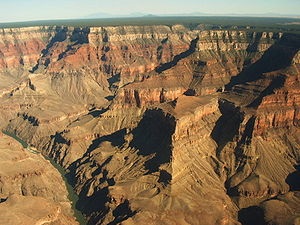|
|
| |
|
|
| |
|
|
|
|
| |
 |
| The Grand Canyon is
an incision through layers of sedimentary rocks. |
Rocks
Rocks are composed primarily of grains of minerals,
which are crystalline solids formed from a chemical
compound arranged in an orderly manner. The aggregate
minerals forming the rock are held together by chemical
bonds. Some rocks also contain mineraloids, which are
rigid, mineral-like substances, such as volcanic glass,
that lacks crystalline structure. The types and
abundance of minerals in a rock are determined by the
manner in which it was formed.
Most rocks contain silicate minerals, compounds that
include silicon oxide tetrahedra in their crystal
lattice, and account for about one-third of all known
mineral species and about 95% of the earth's crust. The
proportion of silica in rocks and minerals is a major
factor in determining their names and properties.
Rocks are classified according to characteristics such
as mineral and chemical composition, permeability,
texture of the constituent particles, and particle size.
These physical properties are the result of the
processes that formed the rocks. Over the course of
time, rocks can transform from one type into another, as
described by a geological model called the rock cycle.
This transformation produces three general classes of
rock: igneous, sedimentary and metamorphic.
Those three classes are subdivided into many groups.
There are, however, no hard-and-fast boundaries between
allied rocks. By increase or decrease in the proportions
of their minerals, they pass through gradations from one
to the other; the distinctive structures of one kind of
rock may thus be traced gradually merging into those of
another. Hence the definitions adopted in rock names
simply correspond to selected points in a continuously
graduated series. |
|
Rock classification
Rocks are classified by their minerals and chemical
make-up. The processes that formed them are also noted.
Rocks may be igneous, sedimentary and metamorphic. Rock
types may change in a so-called rock cycle.
Igneous rocks
Igneous rocks are formed when molten magma cools, either
above or below the surface. They are divided into two
main categories: plutonic rock and volcanic rock.
Plutonic or intrusive rocks are made when magma cools
and crystallizes slowly within the Earth's crust
(example granite). Volcanic or extrusive rocks result
from magma reaching the surface either as lava or ejecta
(examples pumice and basalt). |
|
Sedimentary rock
Sedimentary rocks are the most common rocks on Earth.
They form at or near the Earth's surface. Sedimentary
rock is formed in layers which were laid down one by one
on top of another. Some of the layers are thin, some are
thick. Layers are made by deposition of sediment,
organic matter, and chemical precipitates.
Deposition is followed by squeezing of sediment under
its own weight, and cementation. This process is called
'consolidation': it turns the sediment into a more or
less hard substance.
The approximate amounts of different kinds of
sedimentary rock are: |
- Shale (including mudstone, and
siltstone): 60%
- Sandstones 20%.
- Carbonate rocks (limestone and
dolomite): 15%.
- All others: 5%.
|
Only sedimentary rocks have fossils.
Metamorphic rock
Metamorphic rocks are formed by rocks coming under great
pressure and high temperatures. These temperatures and
pressures are found under mountains and volcanoes,
especially when continental plates move together. These
conditions change the make-up of the original minerals. |
|
Impact on human life
Rocks have had an impact on human life. They have been
used by humans for over two million years. The mining of
rocks for their metals has been one of the most
important things in human advancement. Rocks are mined
for building materials of all kinds. |
|
|
|
|
|
|
|
|
|
|
|
|
|
|
|
|
|
|
Search Fun Easy English |
|
|
|
|
|
|
|
|
|
|
|
|
|
|
|
About
Contact
Copyright
Resources
Site Map |